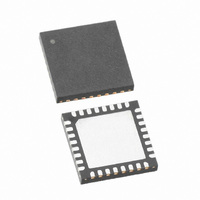SX1212IWLTRT Semtech, SX1212IWLTRT Datasheet - Page 24

SX1212IWLTRT
Manufacturer Part Number
SX1212IWLTRT
Description
IC TXRX 300MHZ-510MHZ 32-TQFN
Manufacturer
Semtech
Datasheet
1.SX1212IWLTRT.pdf
(77 pages)
Specifications of SX1212IWLTRT
Frequency
300MHz ~ 510MHz
Data Rate - Maximum
150kbps
Modulation Or Protocol
FSK, OOK
Applications
AMR, ISM, Home Automation, Process Control
Power - Output
12.5dBm
Sensitivity
-110dBm
Voltage - Supply
2.1 V ~ 3.6 V
Current - Receiving
3mA
Current - Transmitting
25mA
Data Interface
PCB, Surface Mount
Antenna Connector
PCB, Surface Mount
Operating Temperature
-40°C ~ 85°C
Package / Case
32-TQFN
Operating Temperature (min)
-40C
Operating Temperature (max)
85C
Operating Temperature Classification
Industrial
Modulation Type
FSK/OOK
Package Type
TQFN EP
Operating Supply Voltage (min)
2.1V
Operating Supply Voltage (typ)
2.5/3.3V
Operating Supply Voltage (max)
3.6V
Lead Free Status / RoHS Status
Lead free / RoHS Compliant
Memory Size
-
Lead Free Status / Rohs Status
Supplier Unconfirmed
Other names
SX1212IWLTR
Available stocks
Company
Part Number
Manufacturer
Quantity
Price
Part Number:
SX1212IWLTRT
Manufacturer:
SEMTECH/美国升特
Quantity:
20 000
or to fill the FIFO buffers with glitch-free data in Buffered mode. The operation of the receiver is now described in
detail.
Note: Image rejection is achieved by the SAW filter.
In receive mode, the RFIO pin is connected to a fixed gain, common-gate, Low Noise Amplifier (LNA). The
performance of this amplifier is such that the Noise Figure (NF) of the receiver can be estimated to be ≈7 dB.
Following the LNA and first down-conversion, there is an IF amplifier whose gain can be programmed from -
13.5 dB to 0 dB in 4.5 dB steps, via the register MCParam_IF_gain. The default setting corresponds to 0 dB gain,
but lower values can be used to increase the RSSI dynamic range. Refer to section 3.4.7 for additional information.
The second mixer stages are followed by the channel select filters. The channel select filters have a strong
influence on the noise bandwidth and selectivity of the receiver and hence its sensitivity. Each filter comprises a
passive and active section.
Each channel select filter features a passive second-order RC filter, with a bandwidth programmable through the
bits RXParam_PassiveFilt. As the wider of the two filters, its effect on the sensitivity is negligible, but its bandwidth
has to be setup instead to optimize blocking immunity. The value entered into this register sets the single side
bandwidth of this filter. For optimum performance it should be set to 3 to 4 times the cutoff frequency of the active
Butterworth (or polyphase) filter described in the next section.
The ’fine’ channel selection is performed by an active, third-order, Butterworth filter, which acts as a low-pass filter
for the zero-IF configuration (FSK), or a complex polyphase filter for the Low-IF (OOK) configuration. The
RXParam_PolypFilt_on bit enables/disables the polyphase filter.
Rev 2 – June 18th, 2009
ADVANCED COMMUNICATIONS & SENSING
3.4.2. LNA and First Mixer
3.4.3. IF Gain and Second I/Q Mixer
3.4.4. Channel Filters
3.4.4.1. Passive Filter
3.4.4.2. Active Filter
-f
C
Polyphase filter for OOK ( RXParam_PolyFilt_on=’’1’’ )
-f
3
o
Figure 17: Active Channel Filter Description
*
Low-pass filter for FSK ( RXParam_PolyFilt_on=’’0’’)
-f
Fc
C
ButterfFil
t
≤
BW
Page 24 of 77
0
0
passive
,
filter
≤
the polyphase filter
Canceled side of
4
f
C
*
Fc
ButterFilt
f
f
requency
requenc
www.semtech.com
y
SX1212













